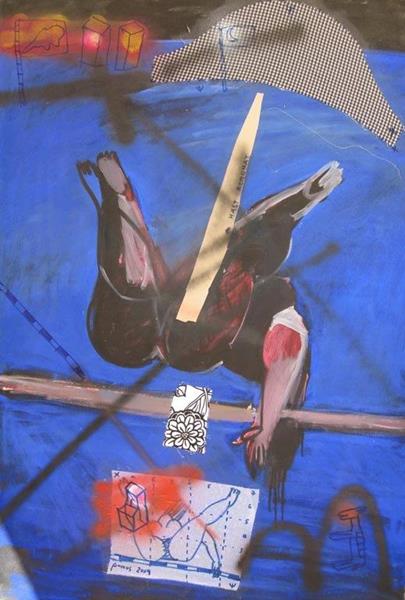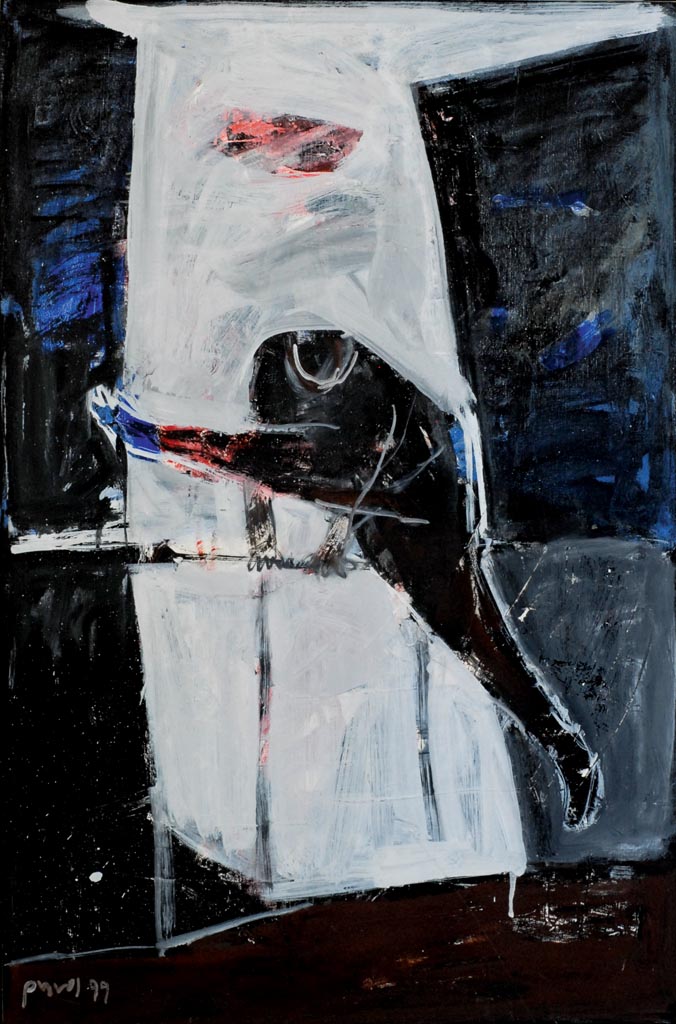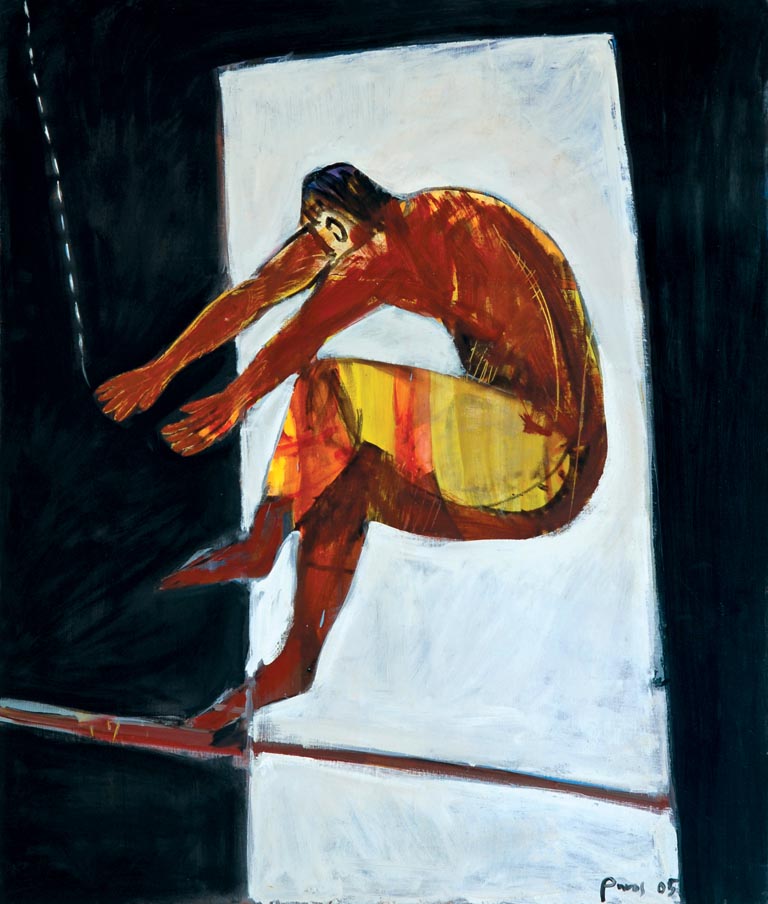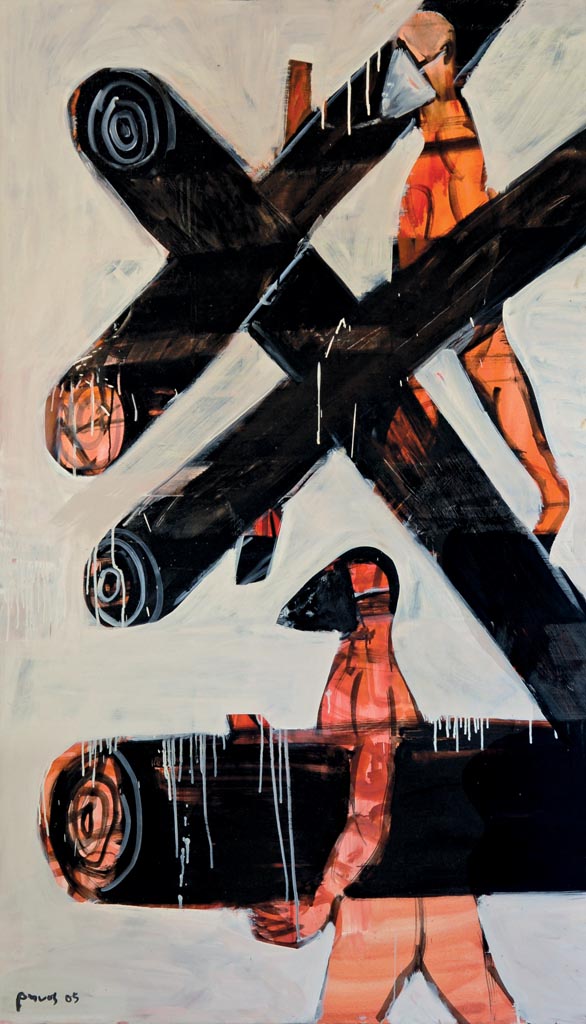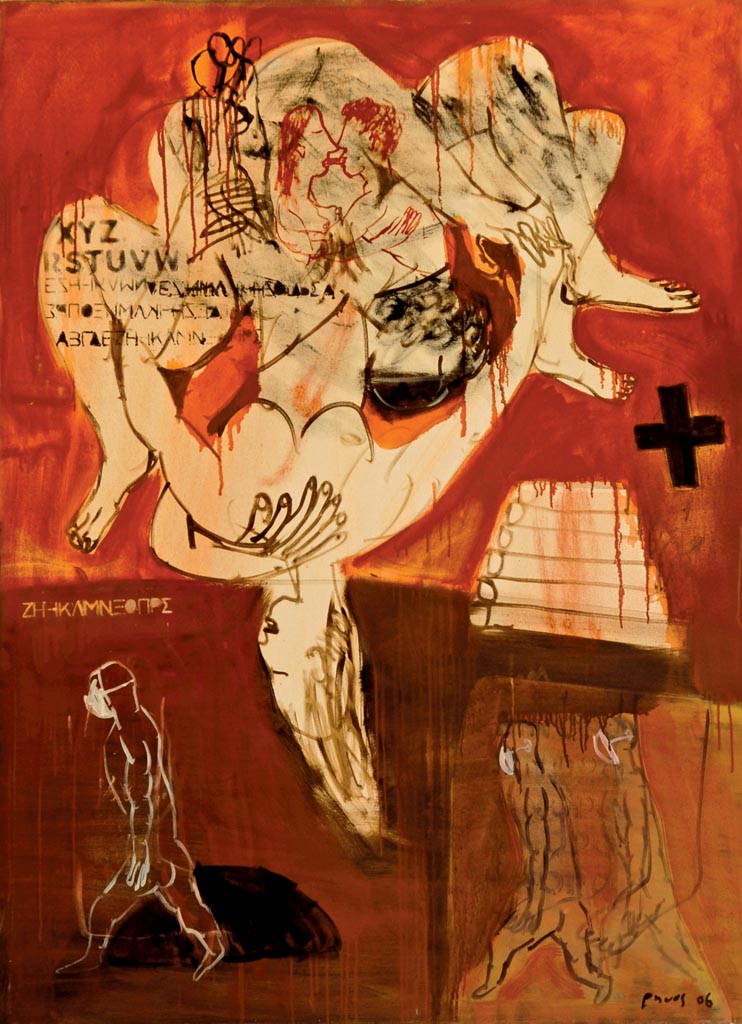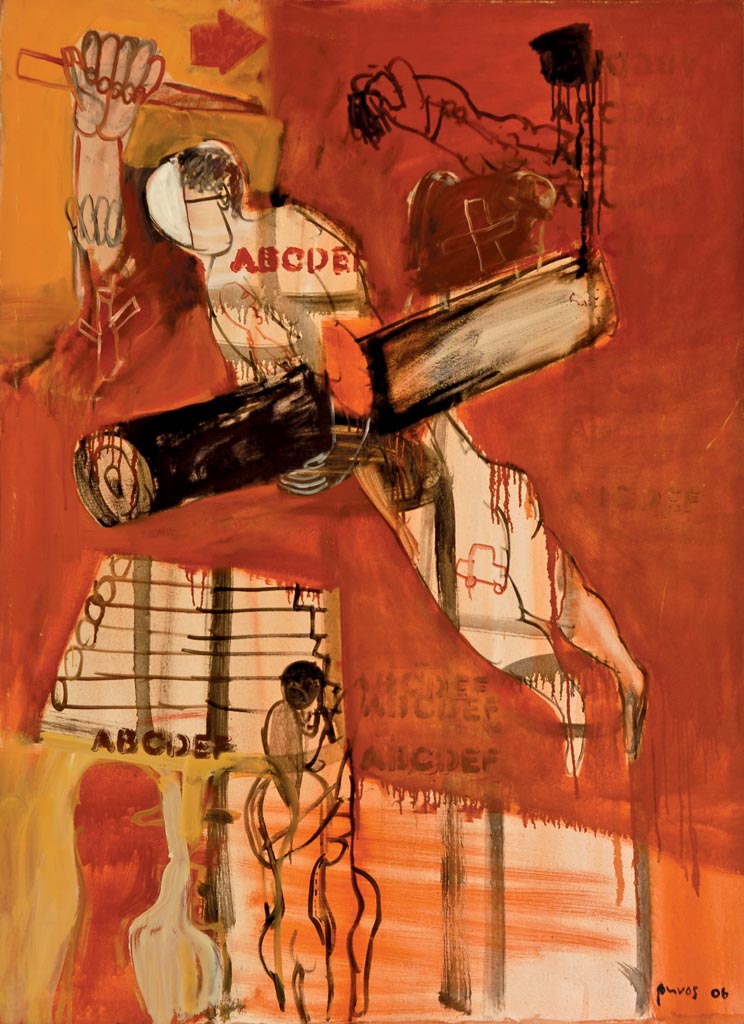In Rinos Stefani’s work Acrobats and Dancers have been occurring for two decades. “Like a modern acrobat, Rinos Stefani each time takes the risk of falling from the tightrope. It is this real risk that gives to his paintings not just the character of representation but the actual “Praxis” itself. Basically, there is no difference between his happenings – Praxeis and his paintings. Since there is continuity throughout his creative process.
The creative process of Rinos Stefani’s work
The creative process of Rinos Stefani, far from his academic standards, is based on a spontaneous variation of motifs. These motifs spring freely from one painting to the other, as interconnected series. They eventually take a form which is «imposed». One that has not been consciously selected, and one that is transformed and enriched semantically. That is why the artist gives titles to his works after he has finished painting. The titles have a very loose connection to the actual content. Let’s take for example, the title of painting According to the Low of the People‘s Republic of China. Stefani base the title from memories of a trip to Beijing. But it’s not directly related to a particular real experience or with the painting itself. This is also the case with the painting Messenger of Alcala street.
The game of Stefani’s titles
The artist establishes a game, at times a sarcastic one but always charming. Between that which is depicted in his work and the title. Shifting the viewer’s thought to other conceptual areas, as surrealists did with poetry. The more the title moves away from the actual content of his work, the more likely it is for the poetic miracle to occur. Rinos Stefani likes the new realities that come about from the connection of two totally different fields. It is the same mechanism that connects, consciously or subconsciously, experiences and memories from those trips that influence him. In the former of the two paintings mentioned above, faces, objects, letters and signs coexist in an unrelated way. What connects them is the single painting surface, which serves a semantic role without, however, defining a specific place.
The erotic and sexual in Rinos Stefani’s work
The key element that dominates in the image is the mingled figures in blatantly exploding erotic positions. Rinos Stefani’s erotic figures seem to be over the moon at the peak of erotic frenzy. It is “an invariably direct, ‘natural’ sexuality, primitive […] eroticism.” Indeed, in his erotic works, there is an unrestrained sexual sensuality, together with a savagery that accompanies it outside social conventionalities.
The artist’s attraction to primitive peoples is not accidental, just as it was not accidental for Antonin Artaud. Artaud with the Theatre of Cruelty wanted to give the power of primitive savagery to the human body. The love couples of Rinos Stefani, as if they are “unchanged images of a primordial ritual” walk on a tightrope. They float – both an image and a symbol of the boldness of the artist, who plays with fire. Images boxed in multiple combinations form a continuous process of deconstruction and construction. Until the artist establishes the final theme of his work.
At the bottom of the painting we see three figures. They are three walkers with disproportionate bodies who move around wearing gas masks. These masks are a symbol of protection from an imminent threat. They semantically define our age since these naked bodies are timeless and are ideally connected with the primitive. Metaphysical concerns, real fears for existing dangers and social criticism are some of the issues that these masks indicate. A motif that recurs in many paintings of the latest series executed by the artist.
The visual signs and motifs
Together with the human figures – acrobats, dancers and lovers -there are words as a direct reference to graffiti. As visual signs which exert a special appeal, irrespective of their semantic content. This is also the case with the timeless symbol of the Cross. Which transcends any allusion to religion and often recurs in order to balance the composition; this element applies also to the arrow in his work Messenger of Alcala street.
Another enigmatic element of his paintings is the motif of the parallel abstract lines: they look like prison bars or steps leading nowhere; yet they are just three trunks; timber piles that impressed the artist when he saw them on a trip to the Amazon Basin; images, which he associates with the memories of the wood piles he saw as a child in his village. Very often in Rinos Stefani’s work there is a merge of elements that characterize different places and time periods, transcending a specific reality. The condensation of allusions, elements and motifs annuls the first obvious perception one has of his works. This emphasizes the polysemy of artistic reality.
In Amacayacu, the same faceless people, always wearing gas masks, move around in an unreal world. They are holding these odd objects under their arms. We are not sure whether they are huge phalluses, which form a cross, an aeroplane, a weapon or even amputated torsos of imaginary beings. Tree trunks, which in other paintings are depicted in piles, acquire here an erotic, threatening and violent content. There is even a reference to environmental problems.
Dr Andri Michael, Art Historian, Faculty of Art [UPJV], Amiens, France. Exhibition “The Body: Stories and Representations”, Evagoras Lanitis Centre, Limassol, 16 June – 31 July 2010
Rinos Stefani’s Acrobat
A lone figure stands out – of male gender (the artist’s alter ego?) – as an acrobat. The acrobat is trying to balance on a tight rope, in a pose that is as much comic as it is inconvenient or awkward, in an effort that is probably doomed, though for the time being, it suspends in uncertainty.
Dr Antonis Danos, Professor of History and Theory of Art, Cyprus University of Technology, 2008.
Lovers, acrobats and dancers with an inner energy
Rinos Stefani’s lovers, acrobats and dancers move by an inner energy to conquer space and time and they do so with anguish, passion and impetuousness. The paintings of the erotic series brandish intense emotional vibrations, full of eroticism and youthful exuberance. Love without guilt, far from hypocrisies and inhibitions. His visual language comes to a sensual peak and reveals unseen aspects of human experience. He plays with opposites with spontaneity, directness and an unbridled passion. His restless spirit and fertile curiosity turn his images of ordinary things into metaphors of metaphysical phenomena of life and death.”
Text by Andreas Hadjithomas, New Epochi magazine, Summer 2004




